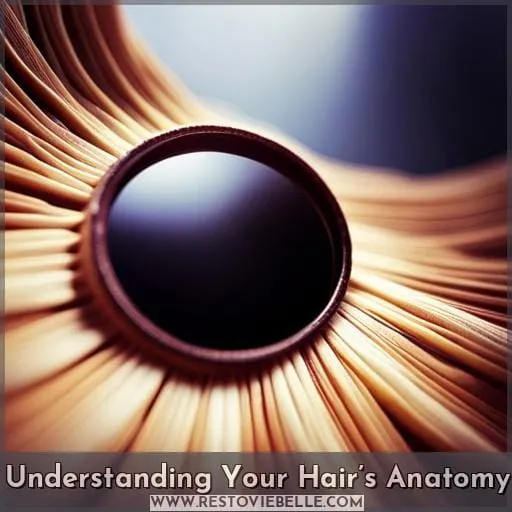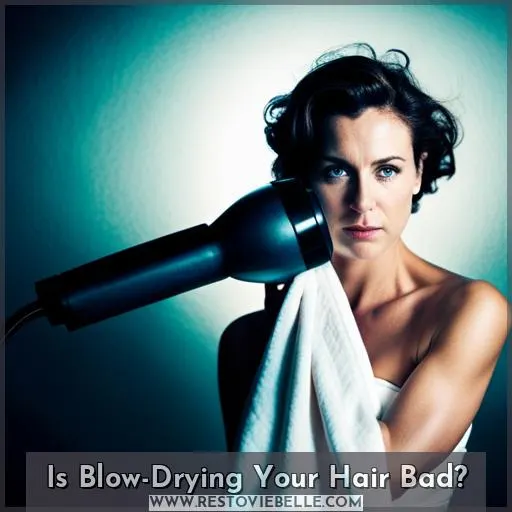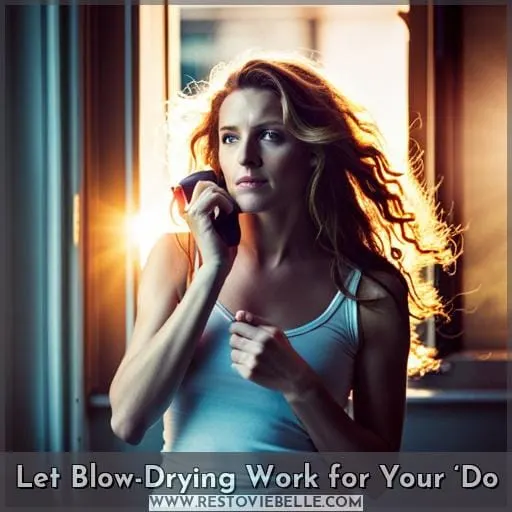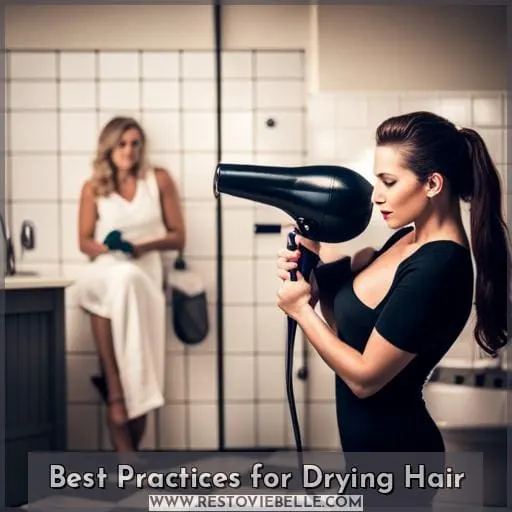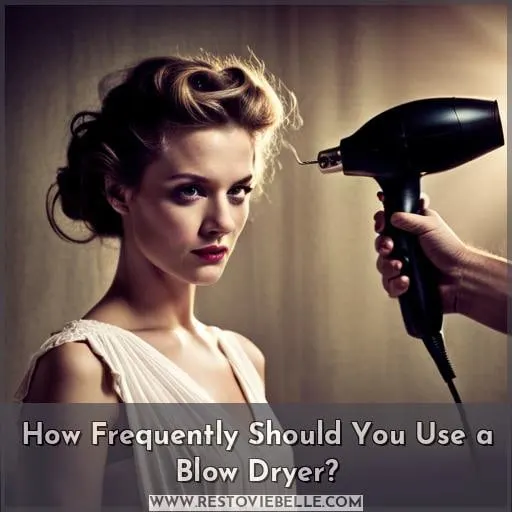This site is supported by our readers. We may earn a commission, at no cost to you, if you purchase through links.
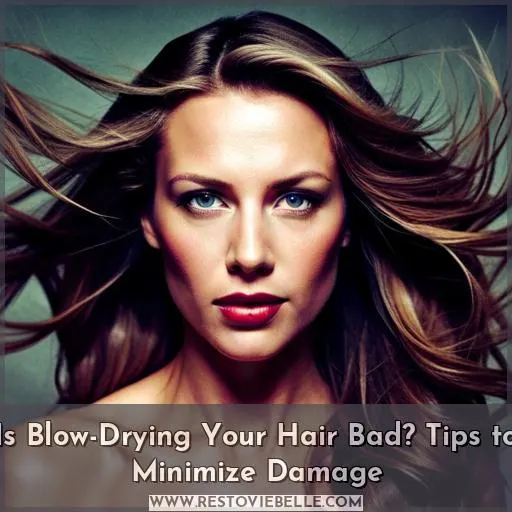 Did you know that over 70% of women use a blow dryer at least once per week? Knowing how to blow-dry your hair properly is essential for avoiding damage and looking fabulous. But what’s the safest way to do it without sacrificing style? This article will provide tips on minimizing heat damage, explain which tools are best suited for each hairstyle, and offer advice on how often you should use a hairdryer.
Did you know that over 70% of women use a blow dryer at least once per week? Knowing how to blow-dry your hair properly is essential for avoiding damage and looking fabulous. But what’s the safest way to do it without sacrificing style? This article will provide tips on minimizing heat damage, explain which tools are best suited for each hairstyle, and offer advice on how often you should use a hairdryer.
Table Of Contents
- Key Takeaways
- Understanding Your Hair’s Anatomy
- Is Blow-Drying Your Hair Bad?
- Is It Good to Let Your Hair Dry Naturally?
- 5 Science-Based Tips to Minimize Damage From Blow-Drying
- Let Blow-Drying Work for Your ‘Do
- How Do You Blow Dry Your Hair Properly?
- What You Need to Blow Dry Your Hair
- How to Blow Dry Straight Hair
- How to Blow Dry Curly Hair
- How Long Should It Take to Blow Dry Hair?
- How to Blow Dry Natural Hair
- How to Blow Dry Hair Straight
- How to Blow Dry Hair for Volume
- How to Blow Dry Thick Hair
- How to Blow Dry Short Hair
- Best Practices for Drying Hair
- How Frequently Should You Use a Blow Dryer?
- Frequently Asked Questions (FAQs)
- Conclusion
Key Takeaways
- Proper blow-drying techniques are crucial for hair health and style.
- Heat protection is essential before blow-drying to minimize damage.
- Different hair types require different blow-drying techniques.
- Air-drying can be less damaging than blow-drying when done properly.
Understanding Your Hair’s Anatomy
Knowing your hair’s anatomy is key to understanding how blow drying can best suit your hairstyle needs without causing any damage.
The outermost layer is the cuticle, which helps protect the other two from heat damage due to its thick cells that overlap each other like shingles on a roof. It also shields against everyday external elements such as dirt and pollutants, as well as styling products that are used during hair care routines.
Just below the cuticles lies another protective layer called the Cell Membrane Complex (CMC).
Lastly, there’s the medulla, a soft inner core made up mostly of proteins, which provides strength and structure.
Taking these factors into account allows you to better understand why proper techniques are necessary for healthy-looking tresses while still allowing flexibility in terms of personal preferences between air drying versus using heat-based methods.
Is Blow-Drying Your Hair Bad?
You may have heard conflicting opinions about blow-drying your locks, but can it really ruin them? Hair type and styling preferences should be taken into account when deciding how to dry hair.
Heat protection spray or damage defense primer is a must before using any heat. It’s best to position the dryer 6 inches away from the scalp and gradually reduce heat as you go for minimal damage.
Opting for air drying instead of blow-drying can help in warm weather. Hydrate while doing so with nourishing masks, use a lightweight towel with a softer weave, and comb through gently with a paddle brush or wide-tooth comb afterwards.
Blow drying also has its benefits if done correctly. Start by conditioning first, then use an ionic hair dryer on low settings along with volumizing mousse, round brushes, etc.
Is It Good to Let Your Hair Dry Naturally?
Letting your hair dry naturally can be an easy and effective way to maintain healthy-looking locks. Air drying is a heat-free option, especially in warm weather. It’s best to lightly towel dry before air drying, which will prevent frizz and keep the cuticle edges from becoming rough or splitting due to water exposure.
Hydrating hair with nourishing masks is key when air drying, as well as using a paddle brush or wide-toothed comb for styling so that you don’t cause any additional damage while brushing out wet strands.
| Protection Spray | Dryer Technique |
|---|---|
| Heat Protectant | 6 inches away |
| Air Drying | Diffuser Attachment |
Compared with blow-drying, air-drying does not expose your tresses to extreme temperatures of 392°F, which may result in irreversible damage if done too often or incorrectly. However, long periods of continuous moisture could also weaken the Cell Membrane Complex (CMC) over time, leading to breakage if proper care isn’t taken while styling damp strands.
To ensure maximum protection against heat exposure, consider adding products like leave-in conditioners and hydrating treatments into your regular hair routine for added shine without sacrificing healthiness!
5 Science-Based Tips to Minimize Damage From Blow-Drying
If you want to blow-dry your hair without damaging it, then start off by conditioning in the shower. Don’t forget to use a silicone-based heat protectant before you even pick up the dryer, and remember that a diffuser is essential for evenly distributing hot air.
Condition First in the Shower
Before you even think about using a blow dryer, make sure to condition your hair in the shower – it’s an essential step for healthy locks! For optimal results, use conditioning techniques specific to your hair type and apply heat protectant before drying.
Towel dry or air dry until damp, then select pliable styling brushes and set the heat setting low. Once complete, finish with cold air for extra shine and protection against damage from blow drying.
Don’t Blow-Dry Sopping Wet Hair
Avoid rushing the process and take your time when blow-drying – it could mean the difference between beautiful, healthy locks and a frazzled mane. Use a heat setting below 140°F, leave-in conditioner, and a round brush for lift; finish with cold air to seal cuticles.
For maximum volume, use boar bristle brushes while blow-drying — this helps reduce heat damage that high temperatures cause on delicate hair strands.
Use a Silicone-Based Heat Protectant
Apply a silicone-based heat protectant before blow-drying for an extra layer of protection that will shield your hair from damage like armor. Heat protection products can help reduce damage to the delicate cuticles and preserve healthy hair fibers.
Selecting an ionic dryer, using the cold air setting, and a boar bristle round brush keeps hardworking tresses safe without sacrificing style! Set the heat at 140°F for optimal results and use a microfiber towel to lightly blot away excess moisture prior to drying.
Mind the Heat Setting
Be mindful of the temperature setting on your blow dryer, as too much heat can cause irreversible damage to your hair.
- Heat protectant spray
- Sectioning clips
- Round brush with natural bristles.
Time-saving while using conditioning products is key to avoid hair breakage or cuticle damage to the cortex. Cold air helps seal in moisture and set styles with reduced frizz, leading you towards healthier locks!
Tack on a Diffuser
For an added boost of volume and to help evenly distribute heat, try using a diffuser when blow-drying your hair. This simple tool attaches directly to the concentrator nozzle on most dryers and reduces frizz while air-drying for a smooth, straight finish.
A boar bristle brush can also be used in combination with high speed/heat settings for additional lift at the roots.
Let Blow-Drying Work for Your ‘Do
Blow-drying is one of the most popular methods for styling hair, but it can also cause damage if not done properly. Knowing how to blow dry your hair correctly and what tools you need can help minimize that risk while still achieving beautiful results on straight, curly, natural, or thick locks.
How Do You Blow Dry Your Hair Properly?
Discover how to properly blow dry your hair for a salon-worthy look at home. Use heat protectant, silicone-based products, cold air, and boar bristle brushes to minimize damage while achieving natural-looking styles.
Start with conditioner first, then add the necessary steps into your styling routine.
What You Need to Blow Dry Your Hair
In order to create a perfect ‘do, you’ll need heat protection, damage defense primer, towel drying technique, and air drying with water-based pomade. Small sections are key for volume; Function of Beauty’s custom hair care is essential.
How to Blow Dry Straight Hair
To get that sleek, straight look without damaging your hair, try blow-drying with an ionic dryer and a round brush. Set heat settings to 140ºF. Air dry haircare masks and sections. Use boar bristles for curly, short, or thick hair.
Pick the right tools: wash, conditioners, and sprays. Avoid excessive heat exposure – diffusers help evenly distribute temperature! Nourish your locks for glossier results.
How to Blow Dry Curly Hair
For those with curly locks, the key to a great blowout is using the right tools and techniques – like swapping out your round brush for a diffuser attachment. Opt for an ionic dryer combined with styling cream; use lightweight towels and boar brushes to minimize frizz.
Air-drying with nourishing masks helps retain moisture while protecting from heat damage, promoting healthier hair growth.
How Long Should It Take to Blow Dry Hair?
You’re probably wondering how long it takes to get that perfect blow-dry look without damaging your locks. Heat settings, air drying, towel drying, hair masks, and brush types are all important factors in achieving the desired shape and style while also helping to lock in the look with minimal damage.
Men’s blowout requires extra steps for hair maintenance such as rehydration and moisturization.
How to Blow Dry Natural Hair
When blow-drying your natural hair, give it a boost of volume and shine with gentle strokes of the brush while adding an extra pop with a figurative sprinkle of confidence. Moisturize before styling to prevent split ends; use heat protection for further nourishment.
For specific tips on different hair types, opt for damp styling over dryer settings and employ cold air rather than hot to reduce damage from overheating.
How to Blow Dry Hair Straight
To achieve sleek, straight locks without the heat damage, learn how to blow dry hair correctly with a few essential tools: an ionic dryer and a round brush with natural bristles; styling products such as a protective heat setting and finishing cream.
How to Blow Dry Hair for Volume
For optimal volume, use a round brush and aim the blow dryer’s nozzle down to coax locks into lushness with each pass. The heat setting, root lift, and volumizing mousse help create the desired style, while cold air ensures the cuticle seals in moisture for added bounce.
Supplement the routine with a boar brush and heat protectant spray, then finish off the look by using cold air to get salon-quality hair without the damage.
How to Blow Dry Thick Hair
Dive into thick-haired styling with a professional blowout look and save time by sectioning your hair for even drying. Avoid pore-clogging products and damaging heat; use moisturizing techniques to protect strands.
The optimum heat setting is 140°F, along with finishing cream for added protection against damage from overexposure to high temperatures.
How to Blow Dry Short Hair
Short hair can benefit from a blow-dry, but using the right technique and tools to avoid heat damage. Pre-styling products provide protection while brush types keep hydration in check, avoiding heat damage with frequency and type of style.
Best Practices for Drying Hair
You may have heard that blow-drying can be a risky business, but the truth is, it all comes down to best practices.
For starters, you need to protect your hair from heat exposure by using a heat protection spray or damage defense primer before applying any hot air.
When drying your hair with a blow dryer, keep the tool around 6 inches away and start at the back and sides before gradually reducing its temperature as it dries.
If you want added volume or even more sleekness for straight styles, then try an ionic dryer.
You should also use diffuser attachments for curly tresses in order to evenly distribute heat throughout, so there won’t be any cuticle damage due to high temperatures (over 284°F).
Air drying can still cause some CMC damage since water continuously penetrates through strands over time.
Finally, if you’re looking into long-lasting hairstyles, remember practice makes perfect, especially when handling styling products like volumizing mousse.
How Frequently Should You Use a Blow Dryer?
Frequent use of a blow dryer can have damaging effects on your hair, so it’s important to understand the best practices for drying. When using a blow dryer, you should consider factors such as heat settings and blower type in order to achieve desired styles while minimizing frizz control.
Depending on your hair type and style preferences, drying time may vary from five minutes up to fifteen minutes or longer – but always remember not to exceed the optimal heat setting (140°F) if possible! It is also recommended that you apply some form of heat protectant prior to each styling session since this will help minimize any potential damage caused by excessive temperatures.
In addition, be mindful about how often you use a blow dryer. Generally speaking, high frequency usage isn’t recommended due to regular exposure leading to weakened cuticles, which can cause breakage over time.
Frequently Asked Questions (FAQs)
What are the best heat settings for blow-drying?
The optimal heat setting for blow-drying hair is 140°F. To reduce the risk of damage, position your dryer 6 inches away and gradually reduce the heat as you go. Utilize a diffuser attachment to ensure even distribution and use protective products before styling.
Should I use a brush or comb for blow-drying?
Brush or comb? It depends on your hair type. For sleekness, use an ionic brush; for fine hair, opt for a ceramic one. A concentrator nozzle is best for straightening, and a diffuser attachment is ideal to distribute heat evenly.
What type of products should I use for blow-drying?
Wondering what products to use for your blow-dry? Opt for a heat protectant spray or damage defense primer, then choose pliable plastic brushes and position the dryer 6 inches away. Use lightweight towels with softer weaves, and nourishing hair masks when air drying.
How can I prevent frizz when air-drying my hair?
To prevent frizz when air-drying, start with a light towel dry and use a paddle brush or wide-toothed comb. Nourish hair with masks and hydrate while drying for maximum volume. Turn upside down to add bounce, then finish by combing through one last time for smoothness.
How long should I wait before applying heat to already dry hair?
Avoid applying heat to already dry hair. Wait until the natural drying process is complete before styling with a blow dryer, straightening iron, or curling wand.
Conclusion
From understanding your hair’s anatomy to mastering the art of the perfect blowout, it’s clear that blow-drying can be a powerful tool when used correctly. Though it may seem counterintuitive, scientific evidence suggests that when done properly, blow-drying your hair may actually be less damaging than air-drying.
With the right precautions, you can minimize any damage that may result from using a blow dryer. Invest in a quality heat protectant and a diffuser attachment, select the appropriate heat setting, and use a gentle towel-drying technique.
Then, use the right products and techniques according to your hair type, and you’ll be on your way to achieving the perfect blowout with minimal damage to your hair.
So, does blow drying your hair damage it? Not necessarily, if done correctly.
